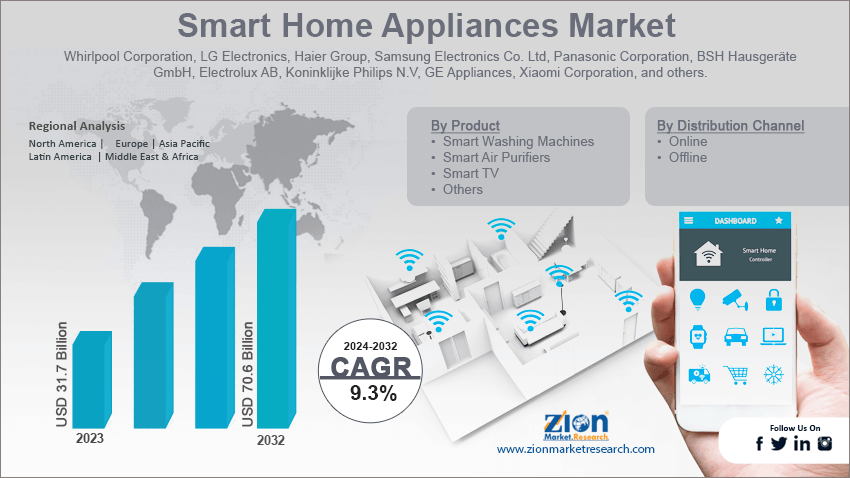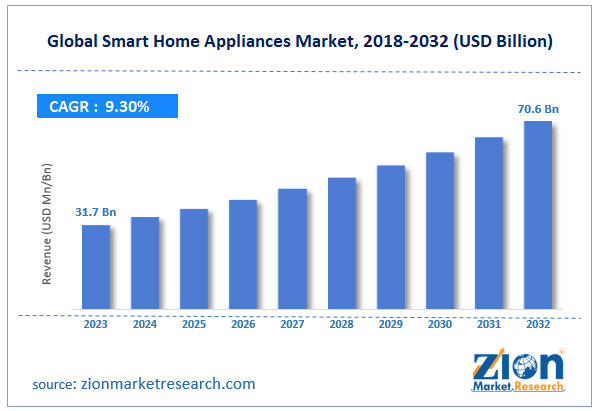Smart Home Appliances Market Size, Share, Analysis, Trends, Growth, 2032

Smart Home Appliances Market By Product (Smart Washing Machines, Smart Air Purifiers, Smart TV, and Others), By Distribution Channel (Online and Offline) and By Region - Global and Regional Industry Overview, Market Intelligence, Comprehensive Analysis, Historical Data, and Forecasts 2024 - 2032
| Market Size in 2023 | Market Forecast in 2032 | CAGR (in %) | Base Year |
|---|---|---|---|
| USD 31.7 Billion | USD 70.6 Billion | 9.3% | 2023 |
Smart Home Appliances Industry Prospective:
The global smart home appliances market size was worth around USD 31.7 billion in 2023 and is predicted to grow to around USD 70.6 billion by 2032, with a compound annual growth rate (CAGR) of roughly 9.3% between 2024 and 2032.
Smart Home Appliances Market: Overview
Using internet connectivity, artificial intelligence (AI), and automation technologies, smart home appliances—domestic products boosting efficiency, convenience, and user experience—are home automation systems, voice assistants (like as Alexa, Google Assistant, or Siri), or smartphones can all provide remote control of these products. The Smart Home Appliances Market is fast expanding in response to growing consumer demand for convenience, energy economy, and automation.
Among other appliances, smart refrigerators, washing machines, stoves, and thermostats mix IoT (Internet of Things) with artificial intelligence to deliver the best performance. Strong acceptance in North America, Europe, and Asia-Pacific is supporting global industry growth.
Key Insights
- As per the analysis shared by our research analyst, the global smart home appliances market is estimated to grow annually at a CAGR of around 9.3% over the forecast period (2024-2032).
- In terms of revenue, the global smart home appliances market size was valued at around USD 31.7 billion in 2023 and is projected to reach USD 70.6 billion by 2032.
- The growing trend towards home automation is expected to drive the smart home appliances market over the forecast period.
- Based on the product, the smart washing machines segment is expected to hold the largest market share over the forecast period.
- Based on the distribution channel, the offline segment is expected to dominate the market over the forecast period.
- Based on region, the Asia Pacific is expected to dominate the market during the forecast period.
Smart Home Appliances Market: Growth Drivers
Growing trend towards smart home automation drives market growth
The business is expanding in response to increased customer focus on smart home automation. These devices enable people to make educated decisions about their health by providing real-time data, tailored recommendations, and easy monitoring. Smart appliance personalizing and customizing point toward a shift to more user-centric technologies. These appliances let consumers modify preferences, settings, and routines to fit their own needs and way of life.
Customizing the lighting, temperature, or even the brewing technique for coffee improves convenience and comfort in all respects. Thus, the growing trend towards smart home automation will positively impact the smart home appliances market during the forecast period.
Smart Home Appliances Market: Restraints
The high cost of technology hinders market growth
The whole cost of the completed goods is much more important because of rising product introductions and home appliance technical developments. New technologies incorporated into the manufacturing process of smart home appliances provide an automated and completely integrated experience, therefore increasing initial investment and continuous maintenance costs for consumers.
To provide the results consumers desire from smart home appliances, most companies, brands, and manufacturers use the latest technology and raw materials. Higher costs of final products are a result of advanced AI technology, personalization, washing machines, smart dials, and other technologies used in smart home appliances needing more complex installation settings. This is likely to hamper the expansion of the smart home appliances industry.
Smart Home Appliances Market: Opportunities
Increasing collaboration among the key players offers a lucrative opportunity for market growth
The rising collaboration among the key market players is expected to drive the smart home appliances industry growth over the analysis period. For instance, in February 2024, using the Matter-compatible technologies, STM32WB55 and FG370, Fibocom revealed the partnership with STMicroelectronics in introducing the smart home solution. It guarantees the centralized control of smart home appliances over several protocols, therefore enabling seamless interactions among them. Working with STMicroelectronics, Fibocom has included the smart home solution into 5G CPE in line with ST's MCU STM32WB and Fibocom's 5G module FG370.
Crucially for bridging the smart home devices as well as assuring the interconnections between the devices in the application layer, the STM32WB supports the Bluetooth/Thread/Zigbee technologies. FG370 provides the docking of STM32WB through a UART peripheral by allowing 5G communication of the CPE, therefore enabling the device "commissioning on CPE". The alignment has improved and opened the imagination of future smart home automation and offered a complete range of conveniences for end users to manage the smart home devices in a 5G CPE without redundant setups.
Smart Home Appliances Market: Challenges
Cybersecurity and data privacy concerns pose a major challenge to market expansion
The growing smart home appliances market presents cybersecurity and data privacy issues as the main obstacles. Connected to the internet, smart appliances—including refrigerators, washing machines, thermostats, and security cameras—are thus susceptible to cyberattacks. Potential targets for hackers able to take advantage of weaknesses to seize control over appliances in a smart house are Cybercriminals who can compromise smart locks, thermostats, or cameras, therefore violating security.
Many smart gadgets also gather and broadcast personal data including usage patterns, voice requests, and even video footage. Privacy issues are raised when certain manufacturers sell or disclose this information to third parties without user permission. Thus, cybersecurity and data privacy concerns pose a major challenge for the smart home appliances market over the forecast period.
 Request Free SampleSmart Home Appliances Market: Report Scope
Request Free SampleSmart Home Appliances Market: Report Scope
| Report Attributes | Report Details |
|---|---|
| Report Name | Smart Home Appliances Market |
| Market Size in 2023 | USD 31.7 Billion |
| Market Forecast in 2032 | USD 70.6 Billion |
| Growth Rate | CAGR of 9.3% |
| Number of Pages | 214 |
| Key Companies Covered | Whirlpool Corporation, LG Electronics, Haier Group, Samsung Electronics Co. Ltd, Panasonic Corporation, BSH Hausgeräte GmbH, Electrolux AB, Koninklijke Philips N.V, GE Appliances, Xiaomi Corporation, and others. |
| Segments Covered | By Product, By Distribution Channel, and By Region |
| Regions Covered | North America, Europe, Asia Pacific (APAC), Latin America, Middle East, and Africa (MEA) |
| Base Year | 2023 |
| Historical Year | 2018 to 2022 |
| Forecast Year | 2024 - 2032 |
| Customization Scope | Avail customized purchase options to meet your exact research needs. Request For Customization |
Smart Home Appliances Market: Segmentation
The global smart home appliances industry is segmented based on product, distribution channel, and region.
Based on the product, the global smart home appliances market is bifurcated into smart washing machines, smart air purifiers, smart TVs, and others. The smart washing machines segment is expected to hold the largest market share over the forecast period. The key element driving the market is that people are becoming more aware of new technology, and the use of smart gadgets in homes has expanded dramatically. Furthermore, changing lifestyles, increased per capita income, and a growing need to reduce overall energy consumption costs are expected to enhance product demand.
Based on the distribution channel, the global smart home appliances industry is segmented into online and offline. The offline segment is expected to dominate the market over the forecast period. Some of the elements driving the popularity of smart home appliance sales through the retail channel include the availability of an in-store associate/expert, assistance with product specs, and the chance for the consumer to physically examine the device.
Smart Home Appliances Market: Regional Analysis
Asia Pacific dominates the market over the projected period
The Asia Pacific is expected to dominate the global market during the forecast period. This is ascribed to the expanding use of cloud-based services, increasing internet penetration, rising per capita income of the regional population, growing acceptance of smartphones, changing lifestyles, rising awareness of personal health, and ongoing government policy encouraging digitalization to be constantly launched.
Furthermore, important forces driving the expansion of the market in Asia Pacific are the rising investments made by multinational companies in the area and the growing demand for modern technology from developing nations, including China and India.
Smart Home Appliances Market: Competitive Analysis
The global smart home appliances market is dominated by players like:
- Whirlpool Corporation
- LG Electronics
- Haier Group
- Samsung Electronics Co. Ltd
- Panasonic Corporation
- BSH Hausgeräte GmbH
- Electrolux AB
- Koninklijke Philips N.V
- GE Appliances
- Xiaomi Corporation
The global smart home appliances market is segmented as follows:
By Product
- Smart Washing Machines
- Smart Air Purifiers
- Smart TV
- Others
By Distribution Channel
- Online
- Offline
By Region
- North America
- The U.S.
- Canada
- Europe
- France
- The UK
- Spain
- Germany
- Italy
- Rest of Europe
- Asia Pacific
- China
- Japan
- India
- South Korea
- Southeast Asia
- Rest of Asia Pacific
- Latin America
- Brazil
- Mexico
- Rest of Latin America
- Middle East & Africa
- GCC
- South Africa
- Rest of Middle East & Africa
Table Of Content
Methodology
FrequentlyAsked Questions
Smart Home Appliances are household equipment that utilizes internet connectivity, artificial intelligence (AI), and automation technologies to enhance efficiency, convenience, and user experience. These appliances can be remotely controlled using smartphones, voice assistants (such as Alexa, Google Assistant, or Siri), or home automation systems.
The smart home appliances market is fast expanding in response to growing consumer demand for convenience, energy economy, and automation.
According to the report, the global smart home appliances market size was worth around USD 31.7 billion in 2023 and is predicted to grow to around USD 70.6 billion by 2032.
The global smart home appliances market is expected to grow at a CAGR of 9.3% during the forecast period.
The global smart home appliances market growth is expected to be driven by the Asia Pacific. It is currently the world’s highest revenue-generating market due to the fast urbanization and increasing disposable income of the population.
The global smart home appliances market is dominated by players like Whirlpool Corporation, LG Electronics, Haier Group, Samsung Electronics Co. Ltd, Panasonic Corporation, BSH Hausgeräte GmbH, Electrolux AB, Koninklijke Philips N.V, GE Appliances and Xiaomi Corporation among others.
The smart home appliances market report covers the geographical market along with a comprehensive competitive landscape analysis. It also includes cash flow analysis, profit ratio analysis, market basket analysis, market attractiveness analysis, sentiment analysis, PESTLE analysis, trend analysis, SWOT analysis, trade area analysis, demand & supply analysis, Porter’s five forces analysis, and value chain analysis.
HappyClients
Zion Market Research
Tel: +1 (302) 444-0166
USA/Canada Toll Free No.+1 (855) 465-4651
3rd Floor,
Mrunal Paradise, Opp Maharaja Hotel,
Pimple Gurav, Pune 411061,
Maharashtra, India
Phone No +91 7768 006 007, +91 7768 006 008
US OFFICE NO +1 (302) 444-0166
US/CAN TOLL FREE +1 (855) 465-4651
Email: sales@zionmarketresearch.com
We have secured system to process your transaction.
Our support available to help you 24 hours a day, five days a week.
Monday - Friday: 9AM - 6PM
Saturday - Sunday: Closed






